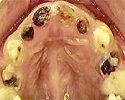Resembling a screw with the texture of human bone, a porous titanium-foam ’root form’ created by researchers at the National Research Council (NRC) in Canada may soon give some solace to individuals with missing teeth.
Licensed in early 2008 to the Toronto-based firm Biomedical Implant Technologies, the novel metal foam could enter the $2bn-a-year dental implant market by next year, depending on the pace of regulatory clearance.
Dr Mislav Pavelic, a Toronto dental surgeon and president of Biomedical Implant Technologies, said: ’NRC’s titanium foam looks like a metallic version of bone. There is nothing else currently on the dental implant market that matches its porosity - nothing that mimics bone this closely and that would allow bone and titanium to integrate.’
Developed at the NRC Industrial Materials Institute (NRC-IMI) in Boucherville, Quebec, the titanium foam is made by mixing titanium powder with a polymer, and then adding foaming agents that expand the polymer when heated. Later, through a high-temperature heat treatment, the polymer is removed and the titanium particles are consolidated to provide mechanical strength to the porous structure.
The metal foam was originally designed for use in electrodes. Louis-Philippe Lefebvre, a powder metallurgy researcher at NRC-IMI, said: ’It worked well and we realised this material could be interesting for a wider range of applications, such as biomedical implants.’
Porous titanium had previously been used in orthopaedic applications, but never for dental implants - although its properties are ideal for this purpose. Lefebvre added: ’The rough surface creates friction between the implant and the bone, and also allows bone growth into the pores to help fix the implant in place.’
Among its potential benefits, titanium foam could make dental implants less invasive. Lefebvre explained that in difficult cases, implantation requires a bone graft. He said: ’With better friction, you can insert smaller implants into less bone so patients may not need bone graft surgery.’
He added: ’If titanium foam implants can reduce the number of surgeries, they will significantly reduce the average cost of dental implant procedures. Better and faster adhesion of the implant should also speed up healing and the insertion of artificial teeth.’

The rough surface of a titanium foam implant creates friction between the implant and the bone, allowing bone growth to help fix the implant in place




Nanogenerator consumes CO2 to generate electricity
Nice to see my my views being backed up by no less a figure than Sabine Hossenfelder https://youtu.be/QoJzs4fA4fo